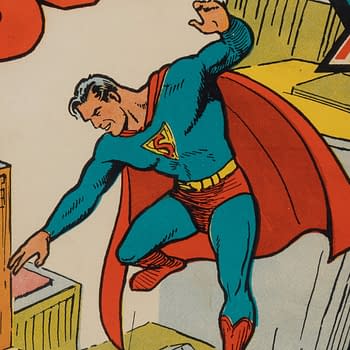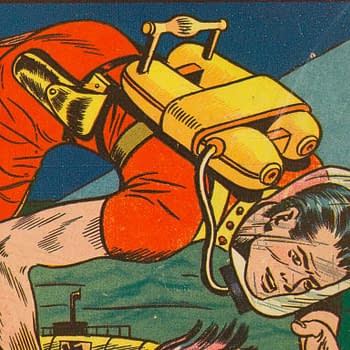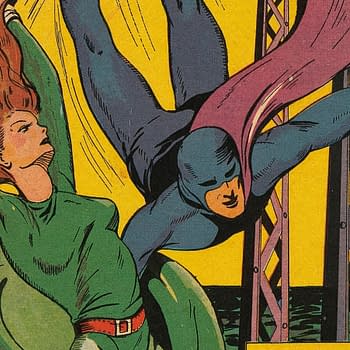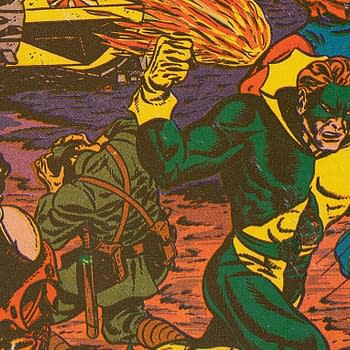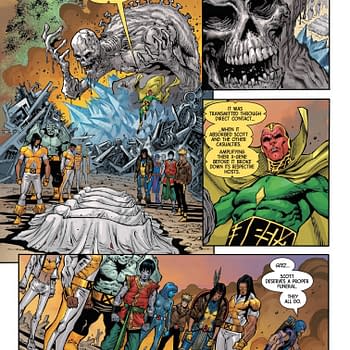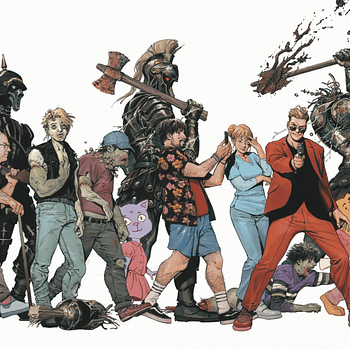Posted in: Comics, Heritage Sponsored, Vintage Paper | Tagged: bill gaines, ec comics, Fredric Wertham
The Historic Horror of Crime SuspenStories #22, Up for Auction
The horrific image on the front of Crime SuspenStories #22 by Johnny Craig has long been considered one of the most iconic covers in American comic book history. It's a potent symbol of that moment in time: EC Comics Publisher William Gaines tensely squaring off against Senator Estes Kefauver to debate the artistic merits of the image in front of a Senate Subcommittee, and the entire nation. Defiantly attempting to douse the flames of the moral panic ignited by psychiatrist Fredric Wertham and Kefauver himself, Gaines was instead consumed by those flames. There's a Crime SuspenStories #22 (EC, 1954) CGC FN- 5.5 Off-white to white pages in this week's 2021 June 27-28 Sunday & Monday Comic Books Select Auction #122126 from Heritage Auctions.

There have been countless books and articles written about the era that Crime SuspenStories #22 symbolizes — mostly centered around efforts to discredit Wertham's obviously dubious research — but we've somehow still gotten the big picture so very wrong. William Gaines was not a perfect man, but the chroniclers of comic book history have still failed his legacy badly.
We've only looked at a small portion of the available evidence leading up to this Senate Subcommittee Hearing. Let's start with the Senator and hopeful candidate for President in this picture, Estes Kefauver.
In 1976, a New York Times investigation concluded that Kefauver had been compromised by the mob during his public hearings as Chairman of the 1950-51 Senate Special Committee on Organized Crime. While this subsequently became a matter of some debate, a look at the details of the era leads me to agree with NYT's assessment of the situation. And it seems likely thoroughly compromised during the subsequent era.
What might they have blackmailed him over? Well, in 2013, LBJ advisor Bobby Baker told Politico:
Senator [Estes] Kefauver [D-Tenn.] had a drinking problem. He smelled like booze all the time, but he was not a mean man. ….he had a bad alcohol problem and he also had a very bad record of wanting to go to bed with every woman he ever met. He got some of these young kids testifying, you know, before his Juvenile Committee or something and then he couldn't wait to go to bed with them.
Kefauver's sexual appetites were apparently an open secret among the press corps during the 1956 Presidential campaign. As Texas Monthly recalled in 1973:
Jack Kennedy and Estes Kefauver materialize, with separate little entourage armies and something more. Both men, it's now apparent, are somehow virtually aswarm with women; a sort of heavenly horny host of nubile admirers, whooping, screeching, clutching, stroking, whispering, whistling, always reaching desperately out—Jesus knows what for?
And Mr. Rayburn, for the first time in hours, seems provoked, curious, amazed. He stares in stonefaced fascination, first at Estes, then at Jack, and then finally at the half-hysterical mobs of barracuda honeys: lovely, leggy, sweetest-smelling li'l ole thangs who never seem to stop smacking their rosy lips or exhibiting their fabulously coiffed and fixtured vital parts and extensions. At long, long last, Mr. Rayburn appears to relax; he even seems to speak, as friends bend close to hear:
"Goddam," he mumbles, "Ever'body screws!"
Perhaps not a man qualified to stand in judgment over the moral decisions of others, in other words. How we haven't factored this into our history of this moment before now is fairly unfathomable. But it gets worse. Let's move on to another figure in this history whose intentions deserve more scrutiny: EC Comics business manager Lyle Stuart.

It's fairly apparent that Stewart played an important role in nudging Gaines and EC along this path from start to finish, and dragging the rest of the industry with them in the process. Stewart — who published his own magazine and books on the side, apart from EC — picked a fight with nationally syndicated columnist Walter Winchell, which ended up in court. During the process, the highly influential Winchell took notice that his antagonist was working for a publisher of horror comic books. Prodded by the public pressure created by Winchell, police investigated EC Comics and purchased a copy of Panic #1 (which hit the newsstands about a month before Crime SuspenStories #22) from the receptionist at their office. When they subsequently wanted to arrest someone for selling obscene material, Stuart volunteered. The case was ultimately dismissed, but in the eyes of the public, the damage was done. It was also Stuart who prodded Gaines into testifying before the Senate, and who helped him craft his testimony.
This sequence of events is sometimes regarded as heroic on the part of Stuart, but I'm very skeptical that's an accurate assessment of his intent. Stuart was by all accounts despised by nearly everyone in the EC Offices except Gaines, and appears to have nudged the process along from the streets of public opinion to the Senate every step of the way.
Indeed, Stuart spent much of his life maneuvering other people into acts of political agitation, such as his associate Paul Krassner, whom he mentored and eventually set up with an office in the Mad building. Krassner, who briefly contributed to Mad in its early days, would later co-found the so-called Yippee movement which most infamously led to the trial of the Chicago 7. Stuart was also the publisher of the Anarchist Cookbook, and subsequent to Timothy McVeigh's 1995 act of terrorism which killed 168 people in Oklahoma City, Stuart republished the book that was said to be a source of inspiration for McVeigh then, and which subsequently became known as the handbook of White Nationalist terrorism — The Turner Diaries, making it more readily available in the wake of Oklahoma City.
Viewed through the lens of the rest of his career, it's difficult not to see Stuart's role at EC Comics as purposeful political agitation.
This brings us to the most scrutinized individual of all in this history: Fredric Wertham. And even in the wake of decades of research by numerous historians, I find it very difficult to conclude that we have anything close to an adequate understanding of his role or intent in this matter.
His wife Hesketh, described as "reclusive to the end" by the Allentown, Pennsylvania Morning Call was an artist and the daughter of the First Baron Hesketh. She instructed her executors not to talk about her to anyone after her death. It might be noted in passing that the current Lord Hesketh and his family are quite active in global political matters. Hesketh's will made explicit that her husband's 'working library' should not be made public until 15 years after her death. Further, records related to Wertham's clinic were to be handled separately in an unspecified way.
Wertham himself appears to have tipped his intent with the very name of that facility that he opened in Harlem: The Lafargue Clinic, named after a man named Paul Lafargue. Lafargue is invariably described in Comics Code-era histories as a physician who just happened to be married to Laura Marx — daughter of Karl Marx. As if he was a doctor with little interest in politics, who married the daughter of one of the most important political figures in world history after a chance meeting somewhere.
But that's not how this story goes. Practically speaking, that description of Paul Lafargue is wrong in every regard — except for the part about being married to Karl Marx's daughter Laura, which he certainly was. Please note that this does not imply that Wertham didn't help his patients or provide a service to a community in need. He did do that. But he likely had other motivations beyond that as well.
Lafargue was an ardent disciple of Karl Marx, who moved his son-in-law and apt pupil around Europe like a pawn. He was a very good propagandist and agitator. He was never a practicing physician, and in fact had no faith in modern medicine. That little fact led to a rather bizarre moment in this history, as Lafarge's father felt compelled to write Karl Marx to complain about his son's failure to pursue his studies as a physician.
This aside, Lafargue played a role in the Paris Commune, and was a signatory of the infamous "Red Poster" that paved the way for it. The Paris Commune seized control of the city using "Communard" agitation tactics in 1871 during France's war with Germany. When Paul and Laura Lafargue completed their suicide pact in 1911, Vladimir Lenin traveled to France to eulogize them. He said in part:
[We in Russia] who have had the good fortune, through the writings of Lafargue and his friends, directly to draw on the revolutionary experience and revolutionary thought of the European workers—we can now see with particular clarity how rapidly we are nearing the triumph of the cause to which Lafargue devoted all his life.
In Europe, too, there are increasing signs that the era of so-called peaceful bourgeois parliamentarianism is drawing to an end, to give place to an era of revolutionary battles by a proletariat that has been organised and educated in the spirit of Marxist ideas, and that will overthrow bourgeois rule and establish a communist system.
This is not obscure history… except among comics historians. The notion that Lafargue, a radical Marxist revolutionary who worked to destabilize the governments of France and Spain, and who made Lenin believe that "a communist system" could be established around the world…and incidentally, had no faith in modern medicine… is a curious choice after which to name a psychiatric clinic in Harlem. Unless you have an appreciation for Marxist revolutionary political agitation tactics.
Being mindful of that theme brings us to another bizarre moment in American history: that time that Southern District of New York Prosecutor and future Donald Trump enforcer Roy Cohn investigated Fredric Wertham. During his preparations for the prosecution of Julius and Ethel Rosenberg, an informant who was acquainted with Wertham told Cohn that Wertham was an ardent Stalinist with connections to numerous key figures in the Communist Party in the United States. Somehow that matter never became public at the height of the Red Scare era — even though Cohn played a key role in that era as Joseph McCarthy's right-hand man.

There's plenty more to say on this subject, such as the fact that the Communist Party in the UK and possibly Australia amplified Wertham's moral panic comic book work, or the fact that Wertham had a close relationship with his cousin, the well-known Communist Propagandist "Red" Ella Winter. Or the fact that according to scholar Alan M. Wald, important black author Richard Wright, who had helped Wertham found the clinic, subsequently based a character of manipulation and fear on Wertham in his book The Outsider, after Wright himself had renounced his Communist Party affiliations. Wright left the Communist Party after concluding that they were manipulating him and other black members for the purpose of political agitation.
But it really boils down to this: It's generally the consensus that Gaines had gone too far with his infamous "Are You a Red Dupe?" ad, in which he accused industry critics of having been duped by Communists.
But there's ample reason to believe that Gaines was probably right. And no one believed him.
This history looms large in the course of comics industry history, and Crime Suspenstories #22 is an apt symbol of that history. There's a Crime SuspenStories #22 (EC, 1954) CGC FN- 5.5 Off-white to white pages in this week's 2021 June 27-28 Sunday & Monday Comic Books Select Auction #122126 from Heritage Auctions, which is worthy of the attention of any serious collector.
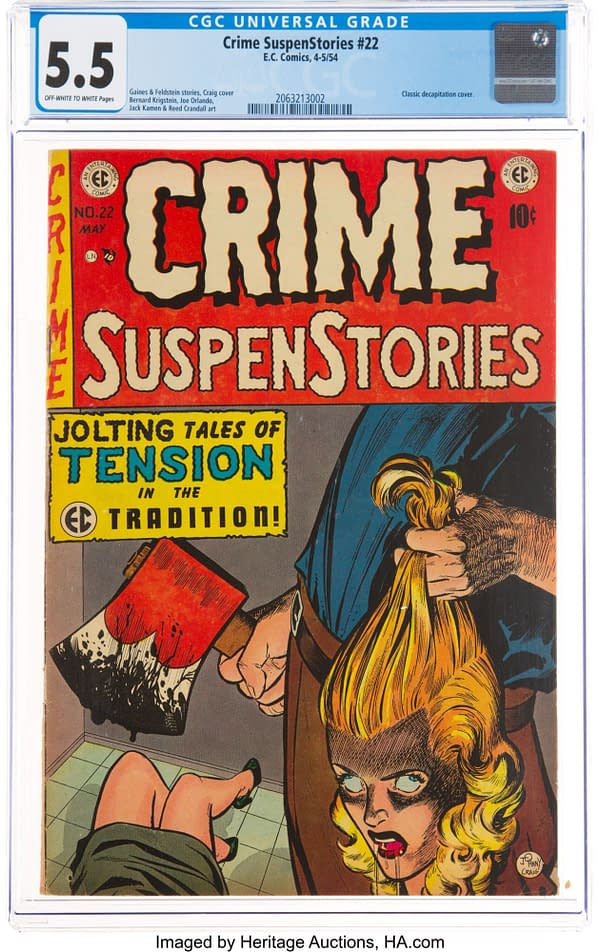
Crime SuspenStories #22 (EC, 1954) CGC FN- 5.5 Off-white to white pages. Classic decapitation cover by Johnny Craig; one of the most infamous pre-Code horror covers ever produced. It was used in a US Senate investigation on juvenile delinquency. Reed Crandall, George Evans, and Jack Kamen art. Overstreet 2020 FN 6.0 value = $2,058. CGC census 6/21: 16 in 5.5, 63 higher.
View the certification for CGC Certification ID 2063213002 and purchase grader's notes if available.





